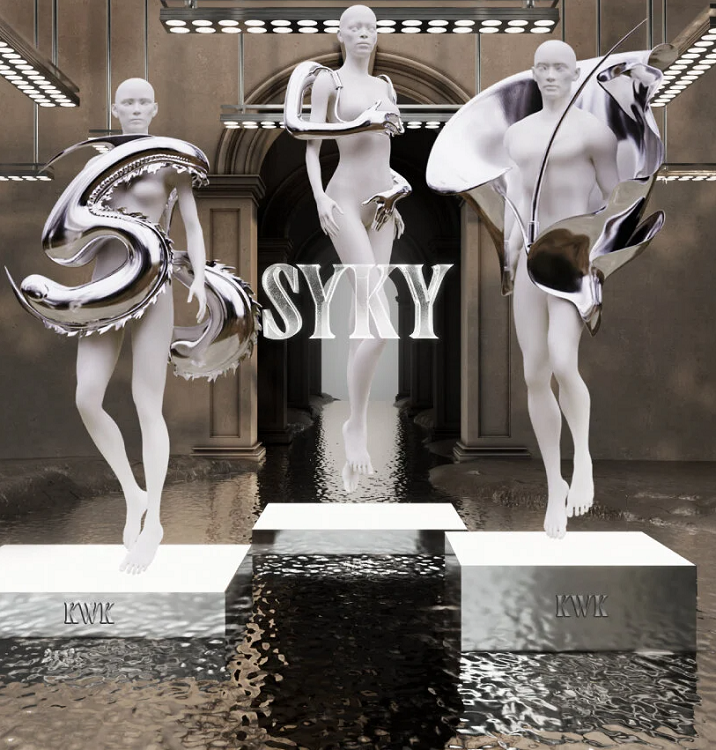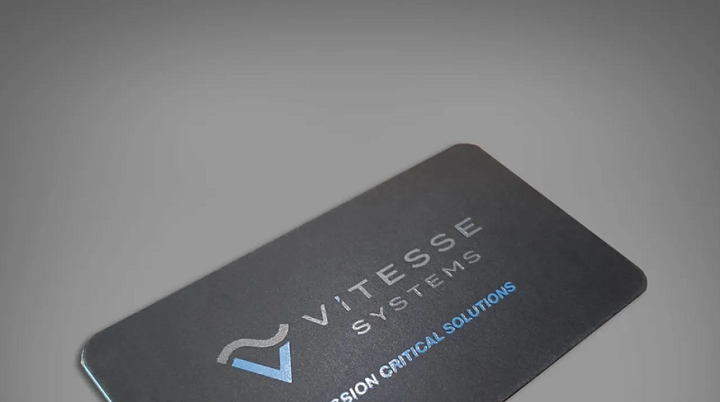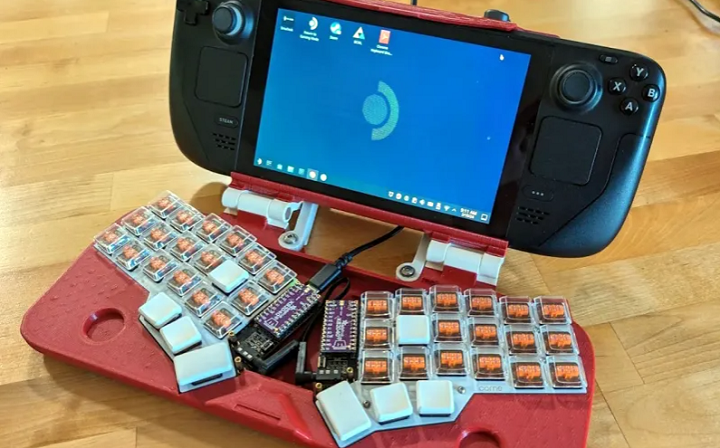In today’s 3D Printing News Briefs, we’re discussing the use of 3D printing in various branches of the military, including the U.S. Coast Guard, the U.S. Navy, and the German Navy. Then we’ll tell you about a 3D printed satellite antenna, before moving on to news about mixed-reality 3D printed art and AI clothes. Finally, a popular video game console gets a 3D printed keyboard dock.
AM Opportunities & Guidelines for the U.S. Coast Guard

Service members on board the USCGC Venturous (WMEC-625) used a 3D printer to replace broken and cracked handles on the Y-gate, which allows a fireplug to feed into two separate hoses. The Coast Guard uses three phases to decide what to print: triage, development, and deployment. Image: U.S. Coast Guard
As Lieutenant Commander Andrew P. Armstrong, U.S. Coast Guard, writes for the U.S. Naval Institute, there are many opportunities for AM in the Coast Guard, so long as the technology is “fully understood and applied sensibly.” Luckily, this military branch has created a set of guidelines to determine how 3D printers can best be implemented. The service evaluates and validates each proposed part for 3D printing using triage, development, and deployment phases. The first, initiated by a request from a member or unit through the normal engineering support path, is the decision to commit time and resources toward 3D printing a part, or not. The standardized request form contains the necessary information for the part, including why there’s a need to print it and to what it is subject to. If the AM integrated product team (AM-IPT) determines that the request is feasible, risk assessment appraisals take place, followed by a criticality assessment, and then the part is assigned a classification—negligible failure consequence, high risk, etc. The final decision is likely made by the local command, but very highly influenced by the technical authority’s recommendation.
The technical work begins in the development phase, where a physical part is created, along with a strong technical data package. Important questions are answered during this phase, such as determining whether the part can be repeatedly produced with the proper dimensions, if it’s strong enough for the task, and what QA checks are need post-printing. An approved technical data package will affirmatively answer the question “Does the technical authority have confidence that this part will perform its functions reliably without undue risk to persons or equipment?” Finally, in the deployment phase, the part is coded in the logistics system, entered into the Coast Guard’s eWarehouse, and made accessible and downloadable to all members. Next steps for the Coast Guard’s use of AM could include using the governance system to start building up an internal network for AM, and also partnering with the rest of the Sea Services by creating a standard process for cross-service part approval.
BPMI Using Lincoln Electric’s Metal AM to Support US Navy
Cleveland, Ohio-based Lincoln Electric operates what it calls the world’s largest wire-based 3D metal printing platform, which has been chosen by Bechtel Plant Machinery, Inc. (BPMI) to help support the U.S. Navy. Lincoln Electric’s AM solution is vertically integrated with high-volume wire manufacturing across 3D robotic cell integration, proprietary SculptPrint OS software, and a range of alloys to print large-scale metal-based parts at a high rate of speed. This development program will advance Lincoln Electric’s proprietary metal AM process for BPMI’s mission critical applications, and the company will be 3D printing very large propulsion components that weight up to 20,000 pounds and measure nearly 10 feet in diameter.
“We are pleased to be a strategic partner to BPMI and support the U.S. Navy’s goal to accelerate shipbuilding. We believe our advanced manufacturing process, supported by inhouse wire feedstock production and industry-leading application, automation and metallurgical expertise can add significant value in meeting the U.S. Navy’s goals,” said Mark Douglass, PhD, Business Development Manager, Lincoln Electric Additive Solutions.
ChatGPT-based Part Vectorizer Tool Available for Public Use
A team of German researchers, including Dr.-Ing. Sascha Hartig, who’s previously spoken at our AMS event, developed an interesting tool, the “ChatGPT-based Part Vectorizer,” which transforms the physical characteristics of a part into structured complexity vectors for manufacturing. Essentially, the Part Vectorizer converts information about a part’s size, quality assurance levels, technical specifications, material class, and post-processing requirements into a complexity vector, which can then enhance production control within AM. This tool was specifically designed for AM requirements, and the OpenAI platform was a central part of its development, as it enabled the creation of a custom GPT (Generative Pre-trained Transformer) without the user needing in-depth knowledge of programming. The final vector follows a format which represents the component’s most important attributes in a standardized form.
“We developed the Funnel-Sieve Model, which allows for more precise control by combining Artificial Intelligence with advanced planning models, thereby improving adaptability to changing requirements,” Hartig wrote in a LinkedIn post.
“The “Part Vectorizer” is now available for public use at: https://lnkd.in/eVvpAKFY. I encourage you to try it out and share your thoughts with me.”
Vitesse Systems Successfully Delivers 3D Printed Satellite Antenna
In 2021, aerospace and defense technology leader Vitesse Systems, based in California, acquired Custom Microwave Inc. to invest in and increase its metal AM capabilities. The company is committed to advancing technology in the aerospace and defense industries, and this strategic acquisition enabled it to expand its design engineering capacity to optimize antenna performance. Now, Vitesse Systems has announced the delivery of its first 3D printed satellite antenna, which has been integrated into the Tomorrow-R1 satellite—the first commercially-built weather radar satellite.
These days, timely and accurate weather data is more important than ever before, and the world relies on satellite technology for communication, navigation, and data collection, so the ability to quickly produce high-performance, cost-effective satellite components is crucial. Vitesse Systems used its new proprietary finishing processes to improve the surface characteristics of its antenna solutions, and designed and tested the 3D printed satellite antenna at its Longmont location. Now added to the Tomorrow-R1 satellite, which launched last year, this antenna could transform the way we build and deploy satellites.
Mixed Reality 3D Printed Art & AI Clothes at London Fashion Week

Kay Kwok’s 3D printed art collection. L-R: Karol G’s NFT custom 3D printed art for Rolling Stone September 2023 Issue; Beyoncé’s NFT custom 3D printed art worn for the Renaissance Tour; Björk’s NFT 3D printed art from KWK Chapter 4 and Chapter 2 series.
At the recent London Fashion Week, designers KWK (Kay Kwok) and Taskin Goec launched mixed-reality pieces of their custom 3D printed art and partially AI-made apparel. Luxury fashion platform SYKY introduced the release, and the show was curated by SYKY Artistic Director Nicola Formichetti, who’s worked with both designers in the past. The pieces by KWK and Taskin Goec were exhibited both physically and digitally, and this is also how they can be acquired: SYKY will sell the collections on its website. KWK’s 3D printed art pieces, each one finished in chrome, were designed for performers and celebrities Beyoncé, Björk, and Karol G.
For his pieces, Taskin Goec trained a custom AI model, based on his previous styles and works, to develop a hybrid collection, and the garments showcase texture generated by the model and physically refined through fraying, pleating, and 3D printing; digitally, cloth simulations and procedural node setups allow the pieces to hold on to their physical features. The collection, titled The Last Dance, has seven digital fashion pieces and a centerpiece design, The Bouquet Baseball Cap, which features a built-in stem holder so the wearer can plant a flower on top of their head. The physical version is 3D printed in Nappa Leather and hand-stitched. The collection also features a set of sculptural jeans and a bouquet top where preserved Amaranthus flowers bloom, a pleated dress in acid chartreuse, a hooded puffer jacket with laser-cut flowers over a twisted silk crepe shirt, and more.
3D Printed Ergo Keyboard Dock for the Steam Deck
The Steam Deck is a full-featured handheld video gaming computer, and while it has many great features, an easy typing experience is apparently not one of them. But some clever modifications by other makers have changed that, and there’s now a 3D printable design for a 3D printed ergo keyboard, or “keeb,” dock that hinges right off the console. The keeb itself is the split ergonomic Corne keyboard, which is available as a kit and also has a 3D printable frame from Thingiverse user a8ksh4 that enables it to clip on to the Steam Deck. The design of the clip and the dock makes it possible to print the hinges and clip separately from the keyboard frame, so you could even use it to mount the Steam Deck to other devices.
“If you’re someone like me however, that’s content to sit on the side-lines and marvel at someone else’s 3D printed creations, it seems like it won’t be long before the community takes advantage of that clever clip and iterates off the idea of adding just about anything you can think of to the bottom of a Steam Deck,” writes Andy Edser for PC Gamer.
“Personally I’d like to see some dual screen configurations, or maybe even a portable mini 3D printed wheel for racing games, just for the sheer giggles. Come on now, 3D printing community, don’t let me down. You know it’d make for a fun project.”
Subscribe to Our Email Newsletter
Stay up-to-date on all the latest news from the 3D printing industry and receive information and offers from third party vendors.
You May Also Like
Further Understanding of 3D Printing Design at ADDITIV Design World
ADDITIV is back once again! This time, the virtual platform for additive manufacturing will be holding the first-ever edition of ADDITIV Design World on May 23rd from 9:00 AM –...
3D Printer Maker EVO-tech Reborn as NEVO3D — Once More With Feeling
EVO-tech was a 3D printing service and original equipment manufacturer established in 2013 and based in Schörfling am Attersee, Austria. The company produced high-quality material extrusion systems featuring linear bearings,...
3D Systems Brings 3D Printed PEEK Cranial Implant to the U.S. with FDA Clearance
For more than 10 years, 3D Systems (NYSE:DDD) has worked hand-in-hand with surgeons to plan over 150,000 patient-specific cases, and develop more than two million instruments and implants from its...
CDFAM Returns to Berlin for Second Annual Symposium
The second CDFAM Computational Design Symposium is scheduled for May 7-8, 2024, in Berlin, and will convene leading experts in computational design across all scales. Building upon the first event...



































